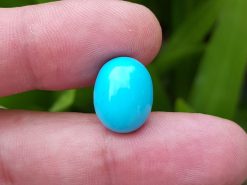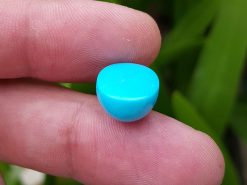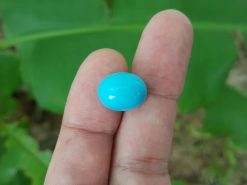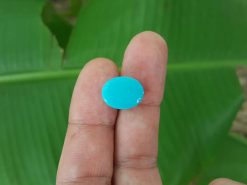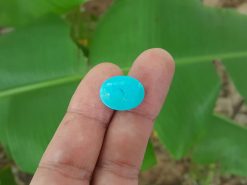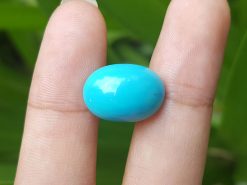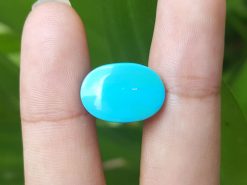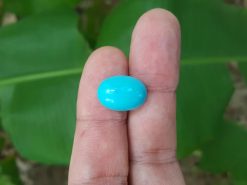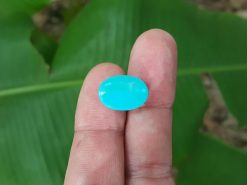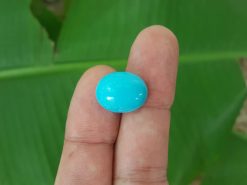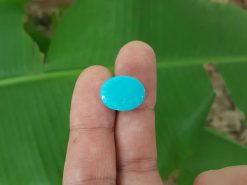Turquoise

We make custom jewelry with turquoise stone as rings, necklace, earrings, bracelet or pendant.
Buy natural turquoise in our shop
Natural stone is an opaque, blue to green mineral. It is a hydrated phosphate of copper and aluminium. with the chemical formula CuAl6(PO4)4(OH)8·4H2O.
A rare and also valuable in finer grades. It has been prized as a gemstone. And ornamental stone for thousands of years. Owing to its unique blue hue. In recent times, it has been devalued. Like most other opaque gems. By the introduction onto the market of treatments, also imitations and synthetics.
Sleeping beauty turquoise from USA
Gemological properties
The finest quality reaches a maximum Mohs hardness of just under 6. Slightly more than window glass. Characteristically a cryptocrystalline mineral. The gemstone almost never forms single crystals. And all of its properties are also highly variable.
X-ray diffraction testing shows its crystal system to be triclinic. With lower hardness comes lower specific gravity 2.60–2.90. And greater porosity, these properties are dependent on grain size. The lustre is typically waxy to subvitreous. And its transparency is usually opaque. But may be semitranslucent in thin sections.
Colour is as variable as the mineral’s other properties. Ranging from white to a powder blue to a sky blue. And from a bluish green to a yellowish green. The blue comes from idiochromatic copper. While the green may be the result of either iron impurities, replacing aluminium, or also dehydration.
The refractive index of the stone is approximately 1.61 or 1.62. This is a mean value seen as a single reading on a gemological refractometer. Owing to the almost invariably polycrystalline nature of the stone. A reading of 1.61–1.65, also birefringence 0.040.
Biaxial positive comes from a rare single crystals. An absorption spectrum may also be obtained with a hand-held spectroscope. It reveal a line at 432 nm and also a weak band at 460 nm. Under longwave ultraviolet light, it may occasionally fluoresce green, also yellow or bright blue, it is inert under shortwave ultraviolet and X-rays.
Turquoise meaning and healing properties benefits
The following section is pseudo scientific and based on cultural beliefs.
The gemstone promotes self-realisation and assists creative problem solving. It is a symbol of friendship, and stimulates romantic love. Turquoise aids in the absorption of nutrients, enhances the immune system, stimulates the regeneration of tissue, and heals the whole body.
Turquoise meaning and healing properties
Turquoise under microscope
FAQ
What is the best quality turquoise?
Bisbee stone is known for being the finest quality gemstone that has ever come out of the ground in North America. The stone runs from light to dark blue and from light to dark green in color, however, the blue color ranges are dominant.
What is the turquoise stone good for?
It is a calming stone that can induce internal serenity and lift depleted spirits. Not only will the stone help to flush negative emotions from the mind, it is also said to support detoxification of the body. Because it aids tranquility and protection, the stone is a great stone to accompany meditation.
What kind of rock is turquoise found in?
The stone is discovered in basalt-covered sandstone, or was initially overlain. There are works of copper and iron in the region.
What is the rarest turquoise?
Lander blue turquoise is from a mine in Lander County, Nevada, USA and was first claimed in 1973. It produced some of the most beautiful spider-webbed turquoise ever discovered. It is considered the rarest and the most valuable stone.
How can you tell the difference between real and fake turquoise jewelry?
Turquoise rings, necklace, earrings, bracelet or pendant does have variegations in color, but dyed stones will have telltale lines, where the dye has collected in the natural cracks of the stone.
Tap it on your teeth. It sounds weird but it works. Turquoise has a dull density when you tap it on your teeth. A fake stone feels like plastic or glass to your teeth.
Is real turquoise expensive?
The price of stones range from $0.05 to $1000 per carat depending on the quality. The difference between quality and cheaper stones can be a little confusing for the non-expert public.
Is purple turquoise jewelry real?
There is no natural purple color turquoise rings, necklace, earrings, bracelet or pendant . It can be reconstituted stones, where the dehydrated rock was ground up and mixed with a red dyed resin, forming the purple color in a plastic reinforced product.
How do you cleanse turquoise?
Dampen a clean, soft-bristled toothbrush in clean water. Gently scrub the surface of the stone with the brush. Dry the whole piece well with a soft towel. Polish the jewelry, especially metal parts, with a jewelry polishing cloth.
Which finger do you wear turquoise?
The strone is for planet Jupiter which is also known as Guru of Brihaspati and it should be wear in Index finger which is ruled by Jupiter and ring finger which is ruled by sun.
Does turquoise crystal bring good luck?
It worn on the body or used in ceremonies, often signified the god of the sky alive in the earth. The stone is said to possess many powers. It is considered a healing and protective stone that enhances courage in the wearer. It is also said to attract love, friendship, money and luck.
Is turquoise precious or semiprecious?
There are only 4 precious stones : Diamond, ruby, sapphire and emeralds. It is therefore a semi precious gemstone.
Does turquoise have gold in it?
The spider-web matrix found in some stones contains gold, various hues of brown, and black, which form an intricate web pattern throughout the light, blue-green color. Because it can be found in a variety of host rocks including chert, shale and quartz, each piece is individually unique.
Is Turquoise shiny?
The gemstone is porous and has a naturally waxy luster. It is sometimes impregnated with a plastic lubricant for to enhance its luster and increase its stability. The stone often contains embedded shiny pyrite flakes, or may contain black oxide veins running through it.
Is African turquoise real?
It is actually not African stone in the traditional sense. Rather, it is a form of jasper that is mined in Africa, and is often treated to give it that rich blue-green color we love about traditional stone.
Is there fake turquoise?
The stone is one of the most commonly faked or imitated minerals on the market, with a majority of it either being dyed howlite or straight up plastic!
Does real turquoise change color?
It is a compound that includes metals such as aluminum, copper or iron. Water and oil can cause some of these metals to oxidize, or in other words rust. As a result of oxidation, the stones can actually change color. Blue stones that contains copper can change from a light blue to a dark green.
What does composite turquoise mean?
Composite or reconstituted stone is made from small pieces of stone that are mixed with a polymer and cast into block-shaped pieces. Finely crushed stone and some non-turquoise materials are sometimes included. The blocks are then sawn into small pieces that are used to cut cabochons, beads and other items.
Is it bad to buy stabilized turquoise?
Stabilized stone isn’t bad. It does have its benefits. In fact, some people prefer it. After treatment, stabilized gemstone is harder and is unlikely to break or crack. The stone is no longer porous, so it doesn’t absorb liquids or oils and the color is locked, unlike natural gemstone where the color can change, or deepen, over time.
Is there such a thing as orange turquoise jewelry?
For the past few years, there are all kinds of dyed blue, white, pink, orange, red, etc., rings, necklace, earrings, bracelet or pendant coming out of China that is labeled as stabilized stones.
Some of it has copper or black colored lines, fake matrix on the surface of it, most of this product is dyed magnesite or something of that sort, not genuine at all.
Natural turquoise for sale in our gem shop
We make custom made turquoise jewelry as engagement rings, necklaces, stud earrings, bracelets, pendants… Please contact us for a quote.



